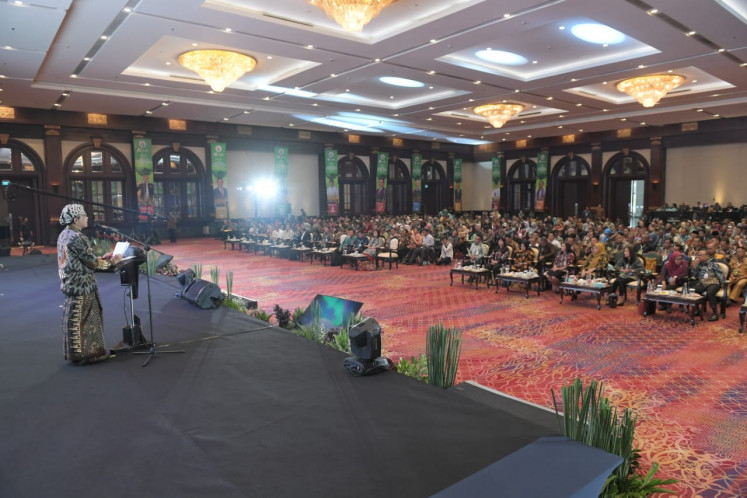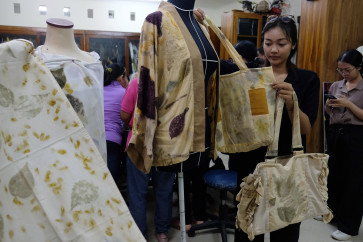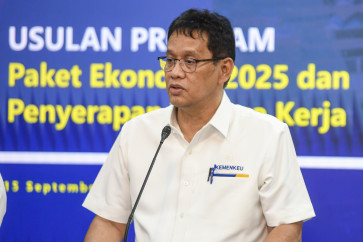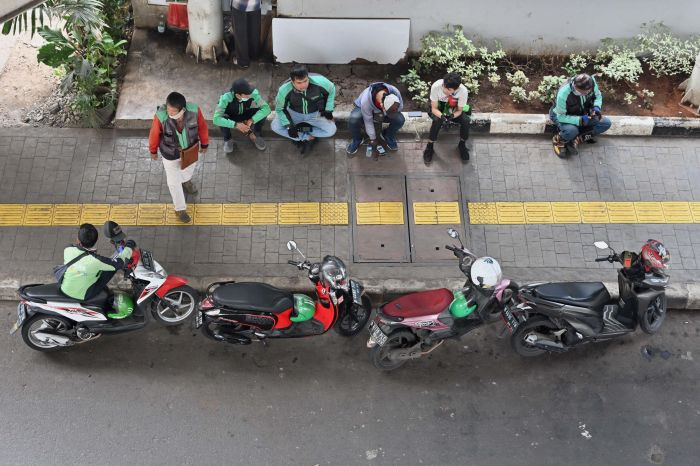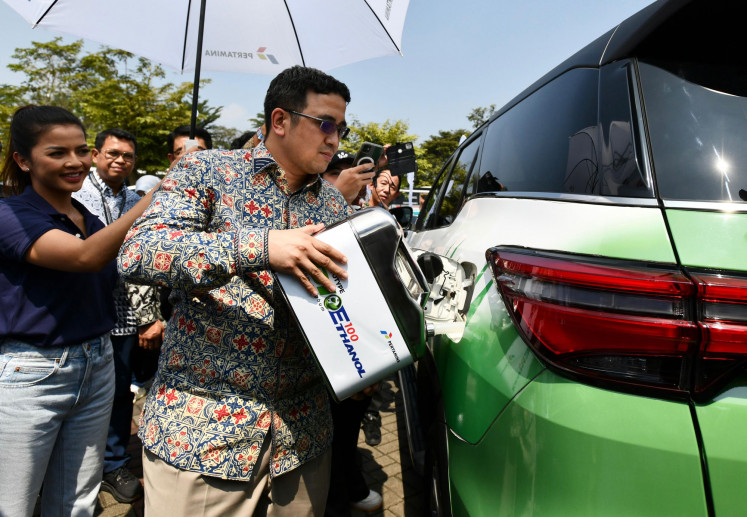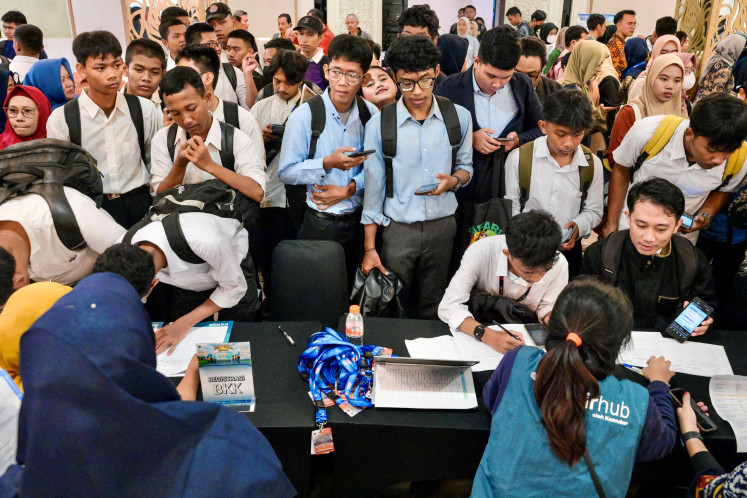Popular Reads
Top Results
Can't find what you're looking for?
View all search resultsPopular Reads
Top Results
Can't find what you're looking for?
View all search resultsMore Indonesian villages elevated to ‘self-sufficient’ status
Change text size
Gift Premium Articles
to Anyone
T
he Villages, Disadvantaged Regions and Transmigration Ministry has made headway in rural development, as evidenced by the growing number of villages whose statuses have been upgraded to “self-sufficient”, thanks largely to disbursements from the Village Fund program to finance development under Law No. 6/2014 on villages.
Villages, Disadvantaged Regions and Transmigration Minister Abdul Halim Iskandar revealed that the number of self-sufficient villages had increased by 11,282, from 174 in 2015 to 11,456 villages this year.
The number of advanced villages, which totaled 3,608 in 2015, had increased by 19,427 villages to 23,035 this year, while the number of developing villages has increased by 5,884, from 22,882 villages in 2015 to 28,766 this year.
Minister Halim presented the data in his opening remarks at the Policy and Implementation Synergy Forum for Development and Community Empowerment in Villages, Disadvantaged Regions and Transmigration, held on Oct. 10 in Jakarta.
He also revealed that the number of underdeveloped villages had decreased by 26,438, from 33,592 villages in 2015 to 7,154 this year. The number of extremely underdeveloped villages, which stood at 13,453 in 2015, had decreased by 8,603 villages to 4,850 this year.
As for regional data, 87 out of 199 regencies had been lifted out of “underdeveloped” status, while another two had earned “autonomy” status, Halim said, with the number of underdeveloped regencies currently standing at just 37.
The increasing number of self-sufficient villages could lend the impression that the process of rural development was complete and so the funds allocated for village development could be reduced, the minister said, but he underlined that independent villages faced more complex challenges compared to extremely disadvantaged villages.
“The reason is because the development of self-sufficient villages will no longer focus on infrastructure, but on economic growth and scaling up the capacity of human capital,” Halim said.
As far as rural development was concerned, infrastructure was among the lightest challenges, because it required funds until construction was complete and did not directly involve dynamical variables like human capital, which entailed sustainable development, he explained.
Therefore, the funds allocated for village development should not be reduced despite the increased number of self-sufficient villages.
According to minister Halim, the successful development of villages, disadvantaged regions and transmigration was heavily influenced by central government policies, the regulatory role of provincial administrations and village innovations.
He said Law No. 6/2014 on villages contained multiple provisions on the administrative responsibilities of regencies and mayoralties, from the election of village heads and recruitment of village-level civil servants to professional training, data inventory and information systems, as well as rural development and budget planning, monitoring and evaluation. Regional administrations also had a duty to impose sanctions on villages that violated any regulations.
“The accelerated development of disadvantaged regions calls for regional administrations to take an active role in developing the strategy,” he underlined.
“The results, utilization and impacts of village development will be greater when the central and regional administrations strengthen their synergy [in terms] of policy and implementation,” Halim said.
The minister went on to reveal an increase in the number of village-owned enterprises (BUM Desa), with the current figure reaching 62,051 units, an astronomical increase compared to just 8,189 BUM Desa in 2014.
He added that 16,199 BUM Desa and 1,376 Joint BUM Desa were registered as business entities, and early this year, as many as 433 BUM Desa had obtained a business registration number (NIB).
However, he noted that many BUM Desa and Joint BUM Desa were still unproductive. This problem could be solved through collaborating and synergizing with other parties, including the private sector, Halim said.
“Through collaboration, I am sure that BUM Desa and Joint BUM Desa can develop in a sustainable manner,” he said.
As for transmigration, the country was home to 154 transmigration regions, 52 of which were slated for revitalization under the 2025-2045 National Long-Term Development Plan (RPJPN).
Halim said the regional transmigration index showed an increase from 48.74 percent to 57.50 percent on average, with as many as seven regions categorized as “having competitive edge”, 33 as “independent” and 12 in the “developing” category.
Collaboration
According to the minister, central-regional collaboration must be based on a shared agenda that focused on addressing the challenges on the ground, along the same policy direction and goals.
This type of holistic collaboration would have a positive impact toward establishing synergy.
“The synergy between the central and regional administrations in managing villages, disadvantaged regions and transmigration must be aligned with the villages, disadvantaged regions and transmigration development blue print,” Halim said.
According to him, the first phase of this synergy road map, running from 2023-2030, aimed to meet Indonesia’s national targets for the Sustainable Development Goals (SDGs) by 2030. The second phase of synergy in 2031-2045 would focus on reinforcing the roles of villages in line with the Golden Indonesia 2045 vision.
Minister Halim expressed his optimism that Indonesia would achieve its SDG targets by 2030, thanks partly to Law No. 6/2014 as the driver of rural development.
At a recent meeting in Bangkok, many countries expressed pessimism about achieving their national SDG targets by 2030, including Goal 1 on No Poverty, citing the impacts of the COVID-19 pandemic as among the major causes.
Minister Halim attributed Indonesia’s optimism about achieving its SDG targets to the government’s quick pandemic handling down to the village level, which was different from the pandemic handling model adopted by many other countries.
“Most of the countries implement the SDGs at the regency or district levels, while the SDGs in Indonesia are implemented to the village level, thanks to Law No. 6/2014, which allows for the distribution of the Village Funds. This has enabled us to talk much about village development,” Halim told a press conference after opening the Forum.
According to the Golden Indonesia 2045 vision, Halim said villages, disadvantaged regions and transmigration development would be characterized by positive trends toward achieving: zero percent of disadvantaged and highly disadvantaged villages, 100 percent of advanced and independent villages, 100 percent of advanced BUM Desa, zero percent of disadvantaged regions and 100 percent of transmigration regions.
The forum saw the attendance of officials from 22 ministries and institutions and 37 Provincial Development Planning Agencies (Bappeda), as well as the heads of 37 Provincial Community Empowerment Offices, 18 Provincial Transmigration Offices, 434 Regency/Municipal Development Planning Agencies, 434 Regency/Municipal Community Empowerment Office and 251 Regency/Municipal Transmigration Offices.
Village Information and Development Agency head Ivanovich Agusta stated in a report presented earlier that the village development policy and implementation synergy forum was an effort to create, establish and follow up communications related to the development of villages, disadvantaged regions and transmigration, in order to synergize the exchange of both central and regional policy messages.
The forum was also marked by setting up the WhatsApp groups for the Nusantara Bappeda heads, Nusantara Village Community Empowerment (PMD) Office heads and the Nusantara Transmigration Office heads to enable smooth discussions on concrete issues. At the same time, these WhatsApp groups would support the creation of solutions that involved all levels and officials while easing the exchange of information about the innovations of various regions.
Smooth communication between central and regional administrations would be akin to an open highway that would not only advance villages, but also alleviate poverty in disadvantaged regions and develop transmigration regions, Ivanovich stated in his report.
He also expressed his gratitude to minister Halim for his innovations, including renewing the 40:40:20 disbursement of the Village Funds toward accelerated village development.
“The COVID-19 Village Response enabled villages to overcome [...] the pandemic from 2020 to 2022,” he added, while also thanking the minister for progress related to the SDGs in 5,265 villages across ASEAN, Asia-Pacific and United Nations countries.
During the forum, minister Halim handed out tokens of appreciation to regents and the regional heads of Bappeda, PMD offices and transmigration offices for their proven innovations and their efforts in strengthening villages, disadvantaged regions and transmigration in their jurisdictions.
Halim also witnessed the signing of a memorandum of understanding on collaboration between his ministry and the Environmental Funds Management Agency, specifically the Economy and Investment Directorate General and the Accelerated Development of Disadvantaged Regions Directorate General.
This article was published in collaboration with Ministry of Village, Development of Disadvantaged Regions and Transmigration



